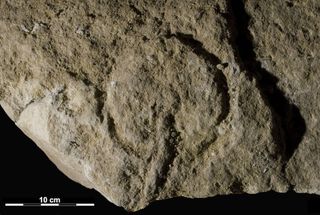Female Genitalia Carvings Are Europe's Oldest Rock Art

The oldest rock art ever found in Europe reveals an interest in the female form — and the type of décor that the first Europeans preferred for their living spaces.
The new discovery, uncovered at a site called Abri Castanet in France, consists mainly of circular carvings most likely meant to represent the vulva. The carvings were etched into the ceiling of a now-collapsed rock shelter about 37,000 years ago, researchers reported Monday (May 14) in the journal Proceedings of the National Academy of Sciences.
"It's quotidian art, it's everyday art," study researcher Randall White, an anthropologist at New York University, told LiveScience. "It's over their heads as they're doing everyday, banal sorts of things."[Photos of the Oldest Rock Art]
Earliest artists
The artists who created this ceiling décor were the first humans in Europe, a group called the Aurignicians. Arriving from Africa, they would replace the Neanderthals in Eurasia.
They were hunter-gatherers, White said, and their society was quite complex. They painted, sculpted and made carvings. Their jewelry included woolly mammoth ivory beads, pierced animal teeth and shells from both the Mediterranean and the Atlantic.
The Aurignicians would have spent winters at the site in southwestern France, perhaps in groups of up to 300 people, White said. These hunter-gatherers found shelter beneath a rock overhang about 23 feet (7 meters) deep and about 6 feet (2 m) tall. On the ceiling, they pecked away rock, carving multiple depictions of notched circles likely meant to represent the female genitalia. (Anthropologists still debate if the images are meant to be vulvas or something else.) Other European rock art sites have similar carvings, White said, though there are regional differences in how the symbols are drawn. [10 Odd Facts About the Female Body]
Sign up for the Live Science daily newsletter now
Get the world’s most fascinating discoveries delivered straight to your inbox.
The Abri Castanet site has been under excavation since 1911, but those early archaeological explorations were not as advanced as today's. Early on, archaeologists found evidence of carvings at the site, but they weren't able to determine exactly where the artwork came from or how old it was.
White and his colleagues excavated down from the top of the collapsed rock shelter roof. When the roof collapsed, it fell directly on the left-behind artifacts from the Aurignician residents, enabling the researchers to date the site to about 37,000 years ago — about 1,000 years older than the cave art at the Grotte Chauvet in France, the previously oldest-known art in Europe.
The researchers weren't sure there was much left at the Abri Castanet site after 100 years of excavation, but the underside of the rock ceiling met their wildest expectations.
"It's an incredible experience," White said. "When we turned that block over, I can't tell you, I got chills up and down my spine."
Inventing art
The site is among the oldest rock art spots in the world, White said. Though modern Homo sapiens arose almost 200,000 years ago, our ancestors left no traces of art until about 40,000 years ago, he said. What the Aurignicians were doing was groundbreaking.
"It's important to think of all of this as an invention," White said.
Vulva imagery may have been of special interest because of a preoccupation with fertility and the mystery of birth, he said. A painted portion of an animal, perhaps a horse, found at the site may have represented dinner, as the Aurignicians hunted horse, reindeer and bison.
The researchers still have at least 164 feet (50 m) of intact ceiling left to excavate, and they hope to find more ancient art.
"We'd really like to be able to excavate that scientifically and to discover the engravings that were over people's heads and the activities that were taking place below and to see if there was any relationship between the two," White said.
You can follow LiveScience senior writer Stephanie Pappas on Twitter @sipappas. Follow LiveScience for the latest in science news and discoveries on Twitter @livescience and on Facebook.

Stephanie Pappas is a contributing writer for Live Science, covering topics ranging from geoscience to archaeology to the human brain and behavior. She was previously a senior writer for Live Science but is now a freelancer based in Denver, Colorado, and regularly contributes to Scientific American and The Monitor, the monthly magazine of the American Psychological Association. Stephanie received a bachelor's degree in psychology from the University of South Carolina and a graduate certificate in science communication from the University of California, Santa Cruz.
Most Popular

